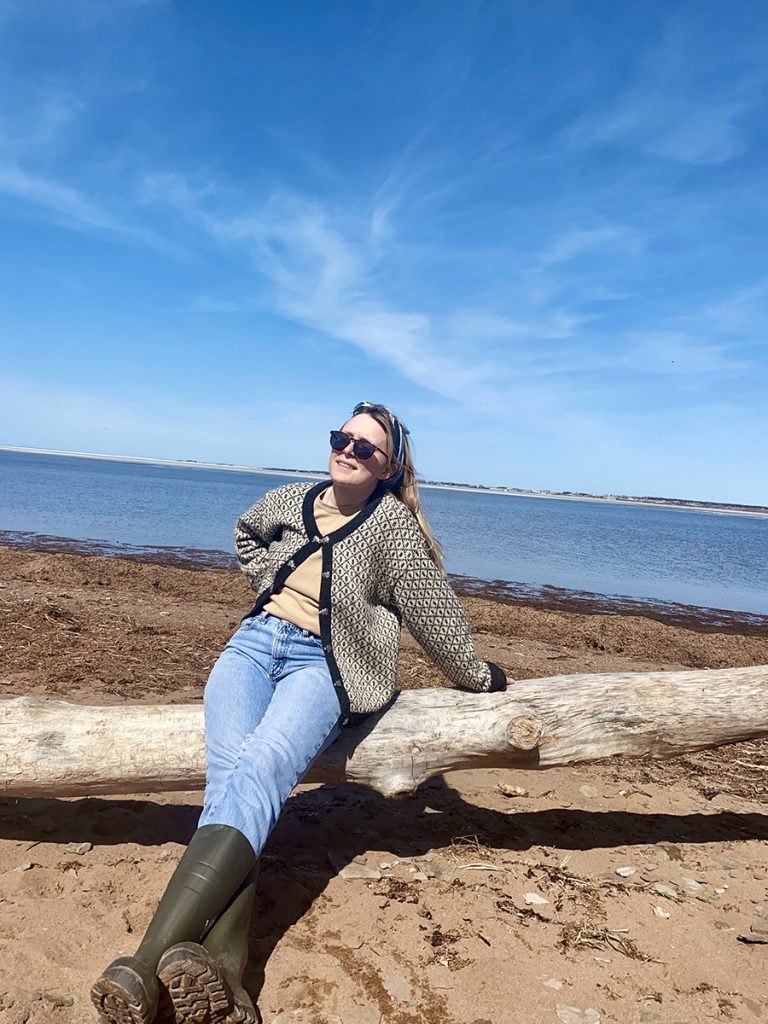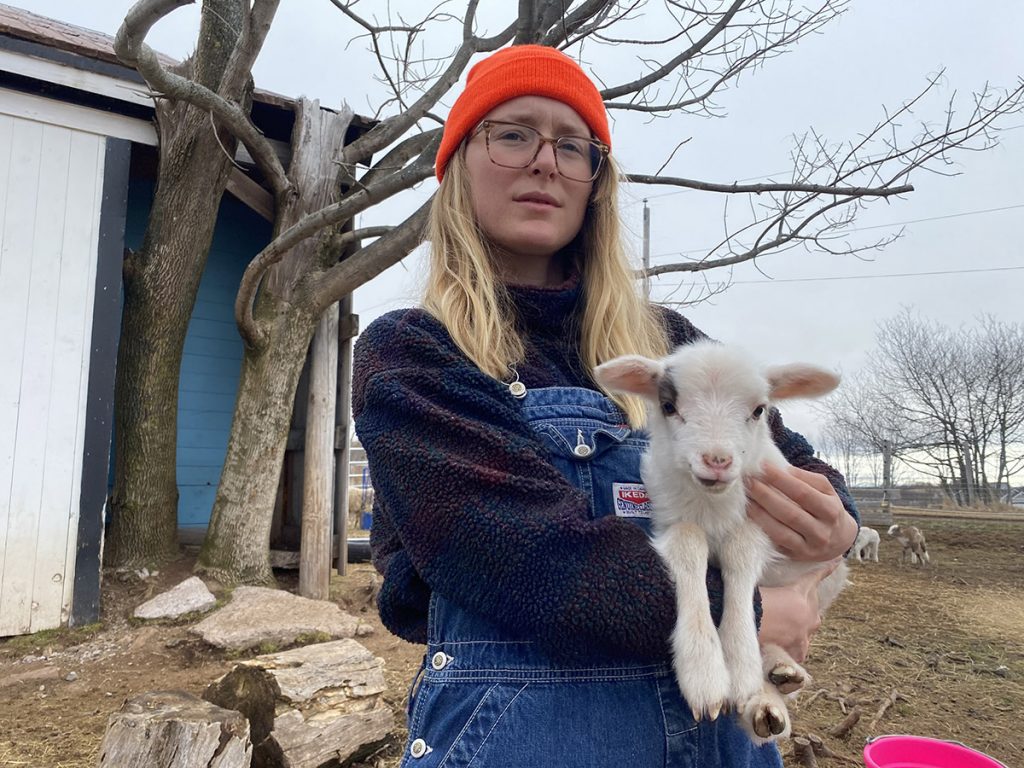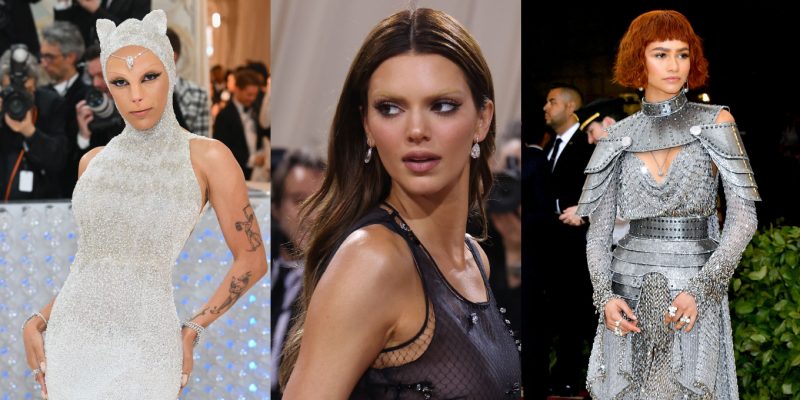Trends
How Moving to a Farm Has Informed My Minimalist Wardrobe
Purposeful consumption has been accelerated by the pandemic, as we rethink our relationship to trend-driven purchases and seek out more sustainable clothing options.
by : Emily Latimer- Jun 18th, 2021

This morning, I woke up and pulled on my flannel-lined blue jeans, a beige waffle knit thermal, and my recently-thrifted LL Bean wool sweater. I headed down to the beach, my trusty rubber boots crunching through muddy patches. I walked along the Northumberland Strait, Prince Edward Island way in the distance, and I watched as birds swooped down, the smell of sea kelp and salt water on the breeze. This is my daily routine; afterwards I’ll feed the chickens, shovel the horse stables, bottle-feed a baby lamb, and maybe tend the garden. Each morning, my clothing choices align with my daily practices.
 Emily Latimer
Emily LatimerBefore moving to the countryside, I was stuck in a seasonal cycle of purchasing mass-produced trend pieces from places like H&M and Zara—cheaply made items I definitely didn’t need and which I’d only wear a handful of times before they went out of style or fell apart. But my move to a rural Nova Scotia farm in January encouraged me to rethink my fashion choices. My relationship to trend pieces, fast fashion, and mass-produced clothing has completely shifted towards a more thoughtful and practical consumption of goods. Now, I get my clothes from second hand stores, thrift shops, and hand-me-downs from relatives.
Purposeful consumption is becoming more prevalent, especially in the context of the pandemic. Increasingly, consumers are moving away from fast fashion retailers that focus on seasonal trends, instead seeking out sustainable clothing options that champion fairness and social justice. A concern for exploitation of human labour and the damaging environmental impact associated with the fashion industry has given some consumers pause and encouraged them to slow their consumption and think more mindfully about their purchases.
2020 was a year of vast cultural change, and trends in consumer behaviour were accelerated by the pandemic. People were at home more, and with that change came a slowing of clothing consumption and a pause in the fast fashion cycle. The McKinsey Global Fashion Index analysis showed that fashion companies saw a 90 percent decline in economic profit in 2020.
 Emily Latimer
Emily LatimerMy shift toward a more minimalist and practical fashion lifestyle actually started last September, when I moved apartments in Toronto. I dreaded the process. I realized that the amount of stuff I was shoving into moving trucks and dragging up staircases was literally holding me back. Fed up after another cumbersome and stressful move, I had to reevaluate the items I would bring with me to the future. The YouTube algorithm happened to recommend a video from a minimalist lifestyle vlogger, and I watched dozens of videos on the topics of sustainability and mindful consumption.
I had so many cheap trend pieces in my closet, I didn’t even know what I had. Compared to 15 years ago, on average, consumers wear clothes 36 percent fewer times. Pre-pandemic, I would rarely repeat an outfit, and I would purchase a new cheap top for a night out or an event. The result was heaps of clothes that never saw the outside of my closet. According to Sustain Your Style, most women only wear 20 to 30 percent of the clothes in their wardrobes. I was definitely one of those women, and I was ready to make a change and weed down my unruly wardrobe.
“Marie Kondo’s 'Does it bring me joy?' wasn’t enough. If that was the only criteria, I would end up keeping everything.”
 Emily Latimer
Emily LatimerInstead, I asked myself: Does it fit me? Is it comfortable? Do I actually like it? Was it a gift that I know I will never wear? Have I worn it in the past two years? Am I keeping this item for my ‘fantasy self’? Does it align with my lifestyle and my values? Is it practical for my everyday life?
Piles of clothes heaped over my bed, and two days later, I had multiple garbage bags ready to be donated. My teenage cousins were excited to be gifted the hand-me-downs, and anything they didn’t want went to friends or to the donation bin. Mentally, I felt a lot lighter, and getting dressed was easier than ever. All my fussy conditional pieces (“I can only wear this skirt with this belt and this exact top”) were banished. As a result, my wardrobe seemed more curated, thanks to its limited colour palette.
Moving to the countryside has been a further catalyst to fundamentally reconsider my wardrobe. Once at the farm, I realized my “warm” clothes weren’t going to cut it. I replaced my Dr. Martens with insulated rubber boots, I swapped my Smartwool socks with cheap synthetic dollar store ones that held warmth better, and I perfected the art of layering, with synthetic fibres close to the skin and heavier wools on top. I survived the frigid winter air by wearing a hat 24/7, sometimes even to bed.
A more minimalist wardrobe has encouraged me to truly cherish every item. My aunt’s IKEDA overalls from the 1990s have been a saving grace, I pop them on over any outfit to protect myself against the messiness of farm life. Practicality and durability are what informs my fashion choices now—I dress for the weather, which means I’m more in touch with the cyclical nature of the seasons, rather than the cyclical nature of fashion trends.
I redefined my values and therefore the purpose I want my clothes to fulfill. I want to be comfortable and unfazed when a barn kitten jumps up on my jeans with a muddy paw. I want to be unrestricted and to move freely, ready to chase after a baby lamb if she needs to be fed.
Of course, you don’t have to live on a farm to implement more thoughtful practices into your consumption. Before you purchase anything new, consider whether it makes sense for your daily life. By realigning your purchases to match your values, you can chart a pathway to more ethical purchases.
Read more:
8 Fashion and Beauty Brands That Are Certified B Corps
7 Ways to Make Your Beauty Routine More Sustainable
This New Cookbook Is Here to Help You Eliminate Kitchen Waste
Newsletter
Join our mailing list for the latest and biggest in fashion trends, beauty, culture and celebrity.
Read Next

Beauty
The Best Met Gala Beauty Looks Of All Time
From Taylor Swift's 'Bleachella' era to Rihanna's iconic 2011 braids, meet the best beauty moments in Met Gala history.
by : Katie Withington- Apr 26th, 2024

Culture
Benny Blanco Says He Fell in Love With Selena Gomez Without ‘Even Noticing’ It
Allow Benny Blanco to tell the straight-from-a-rom-com story of how he realized his feelings for his girlfriend and longtime friend.
by : Alyssa Bailey- Apr 26th, 2024

Beauty
Summer Prep: How to Feel Confident in Your Swimsuit
New Size-Inclusive Swimwear: Gillette Venus partners with The Saltwater Collective to Launch a Collection for Any Body
by : ELLE Canada- Apr 24th, 2024




